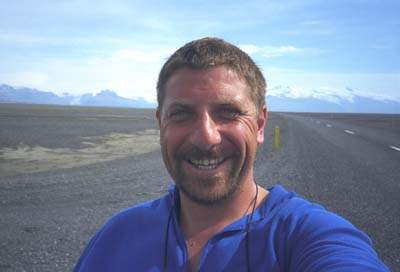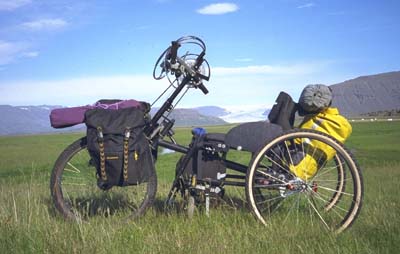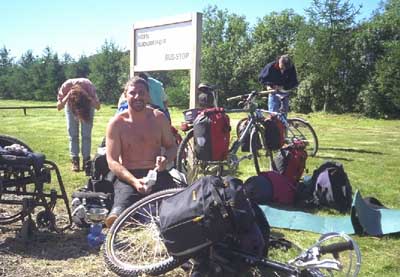
|
|
| Background
After serving 10 years in the army with the Royal Green Jackets in May 1991 I was involved in an IRA bombing in Belfast whilst serving as a Tracker dog handler. This resulted in the loss of both of my legs, various other injuries and my eventual medical discharge from the army at the age of 26. Since that time, I have found myself becoming involved with various activities and projects. I occasionally work as a Tv and film extra and also work on a voluntary basis as a classroom assistant. I have always had a passion for travel and outdoor adventure activities and this has led me to become involved in a number of projects both solo and with others of the same mind. |
|
| This project was originally planned as a solo and unsupported trip by myself, after seeing a presentation by John Birdsall during a seminar at the Royal Geographical Society in Oct'95. His journey by motorised trike across Iceland's interior awed and inspired me. The 1997 Coppermine River expedition in Canada, of which I became a |
|
| member,
was also conceived at this seminar and so the Iceland trip was no more
than a pipe dream at this point, until 1998 when the Canadian
expedition was finished
On my return from the Canadian expedition in late '97 an ex army buddy of mine, Steve Cornwall and I, were having a drink or two one night and he expressed a desire to become involved in some form of expedition or outdoor adventure. I was reminded of the Birdsall trip and put it to him that this might be something we could do on a mountain bike and a hand powered trike, he agreed and wheels were set in motion (no pun intended). We decided quite early on in the preparations to utilise the trip by raising money for a charity. Steve is a great dog lover and I, as well as having a disability, was an Army dog handler. So we both agreed that Hearing Dogs for Deaf People was a much needy and worthy charity, as with many charities funding is always a problem but equally, the raising of awareness is a big issue. We set about looking for funding and support for the trip itself but it soon became apparent to us that the challenge of cycling across Iceland did not appeal to the potential sponsors that we contacted (no names, no pack drill) so we resigned ourselves to self-funding. |
|
| The original idea was to follow in John Birdsall's tire tracks and use one of only two routes that traverse Iceland's interior. John had used a notorious route called the F26 or Sprengisdur, travelling from Reykjavik in the south to Raufarhofn in the north. On contacting Pall Gudjonsson of the Icelandic Mountain Bike Club (IFHK) he confirmed what John had told me, that this particular route was an extremely hard |
|
| and
often impassable track that even groups of hardy well experienced
mountain bikers have had difficulties on. After some long discussions
we opted for a route to the west of the Sprengisdur, the F35 or the
"Kjolur". This meant a slightly longer route, but one that
is more certain of success as the major rivers are bridged and there
are a few more vehicles on it in case you need assistance.
Shortly after this decision was made, Steve who was in the middle of setting up his own furniture restoration and repair business and also going through the rigours of buying a cottage in need of repair, very reluctantly had to drop out of the project. (With I might add a push from me, it just wasn't fair too put pressure on him to follow the project through). So in May of '99 it was once again a solo trip. I needed to rethink some aspects of the trip, I was not going to have a backup vehicle and support team, the issues of quantity and weight distribution i.e. the amount of food, gear and spares etc became even more important. Ultimately I found that I needed to alter the way my trike was to be set up. Enter, Vincent Ross at Chevron in Liverpool who designs, manufactures and supplies wheelchairs and associated equipment. He set to work building and renovating an old wheelchair of mine that had already been adapted to take an earlier version of the "Easyrider" some four years ago. The new trike had to be capable of coping with the tracks and the hills that I would be encountering on the trip. The new front portion of the trike has 21 gears, standard braking system and a larger wheel. When the trike was ready I collected it from Chevron at the Mobility Roadshow in Crowthorne. |
|
| The idea of pulling a trailer was considered but after much discussion it was decided that to pull a trailer was just not feasible. So an alternative method for carrying my gear had to be found. With time at a premium Dave Russell of Russell Cycles, Twyford offered to help adapt and fit a carrier for panniers. With only days to go and with the help and advice |
|
| of Michael and Karen at Cycleman in Ashford who were instrumental in finding the right spares and equipment and also able to give me a good discount, I packed, repacked, adjusted and minimised down to bare essentials. The front wheel, with the two large panniers, needed to have some weight over it to help with traction but too much weight meant that the steering was affected. On the rear of the trike I loaded a waterproof bag with the lightest gear because to much weight at the back acted as a drag, the heaviest gear was placed in two smaller panniers and slung like saddlebags over the centre of the trike. Finally with the bare minimum and only a World Band transistor radio as a luxury the ideal weight distribution and packing system was found. | |
| With all the preparations complete on the 21st July, my wife Sarah dropped me at Terminal 1 Heathrow and I was on my way. After negotiating the rigours of check-in and security, which is never an enjoyable task especially in a wheelchair and after a security alert that delayed the flight I took off for Iceland. I had visited Iceland once |
|
| before, now as the aircraft banked around for it's final approach and landing I was treated to a wonderful view of the two glaciers that dominate the south of the island and have stuck in my memory since 1987. | |



